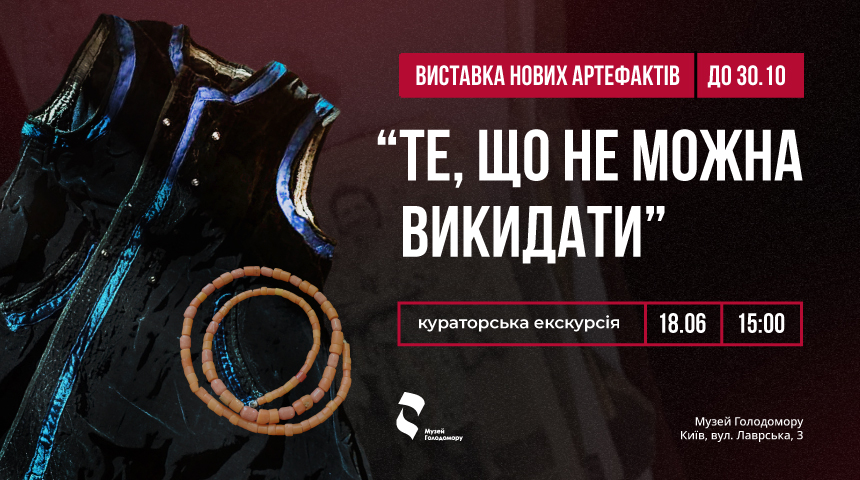The Holodomor Museum has a permanent exhibition of the Museum’s new arrivals. A curatorial tour will hold on June 18
In the Holodomor Museum, there is an exhibition of the Museum’s new arrivals. Unique towels, shirts, corals, and other artefacts related to the Holodomor are already in the Hall of Memory
A curatorial tour will hold on June 18. We invite media representatives.
The collection of funds is one of the main functions of every museum. Not so many things related to the Holodomor period have survived till our days. Therefore, every artefact of that period is of great value to the museum. Today, the funds are replenished mainly thanks to donators – Ukrainians who want to share family history and preserve the memory of their relatives – victims and witnesses of the Holodomor.
Some of the most valuable exhibits that got to the Funds are in the showcases of the Hall of Memory. Visitors to the museum can learn them and their stories. So, in May 2023, the Museum will present an exhibition of new arrivals with the symbolic title “Things that cannot be thrown away,” which includes, in particular, the following exhibits:
- Coral beads of Sofia Kulykovska’s family, preserved from the time of the Holodomor. Ms Sofia’s parents had to exchange all their jewellery and valuables for food, but this very necklace was saved and, many years later, ended up in a museum
- The homespun blanket remained after the dekulakization of Hanna Rusyn’s family. Her mother, who was warned about the eviction, realising that everything would be taken away, asked her fellow villagers to hide some of the things. In this way, it was possible to save some of the property, in particular, and this is quite a lot.
- The wedding towel of the priest and teacher Oleksii Vobly, who saved the children of Piskoshyne village in Zaporizhzhia from starvation. In the early 1920s, the mother embroidered it for her son’s wedding, which took place in the church of Yanovshchyna village in the Poltava region. Eventually, fate left the young family in Piskoshine, where the head of the family was a teacher. In the famine years of 1932–1933, Oleksii and his wife Maria set up a canteen at the school. Thanks to this, not a single child in the village died during the Holodomor.
- Part of an icon written on metal from Potiivka village in the Zhytomyr region. When the church there was closed in the 1930s, the metal icon was used to… build the roof of the local shop.
- A wooden tablespoon that belonged to Anastasia Vasyliuk from the Zhytomyr region. She gave it to her niece with the words: “She rested during the Holodomor, use it always, so that she never rests with you, so that no one knows such grief again.”
- A corset of unknown origin, bought by Ukrainian Victoria Kulko and transferred to Britain. After the examination, Victoria suddenly found the remains of ears of grain sewn into the lining of the casket. It is known that during the Holodomor, people could use hidden pockets and holes in their clothes to save at least some amount of grain or other food. The story with the corset gained publicity in the media, and Victoria agreed to transfer the exhibit to our Museum.
Among the presented exhibits, there are also artefacts about the origin of which detailed information has not been preserved. After 90 years, hardly anyone can testify to whom they belonged and what fate befell the owners. Just as no one will name absolutely all the names of millions of Holodomor victims. But this is the historical legacy of Ukrainian society, traditional markers of the group that was destroyed. And these things must be preserved.
The Holodomor Museum invites you to see an exhibition of new exhibits from its collection and immerse yourself in the history of the gravest crime of the 20th century against the Ukrainian people.
On June 18, at 3:00 p.m., there will be a curatorial tour by Yana Hrynko, head of the exposition and exhibition department of the Holodomor Museum, and her deputy, Maryna Bohush, who will tell in more detail the unique stories of the exhibits and their way to the showcases of the Hall of Memory. Media representatives will have the opportunity to receive comments from our experts.
For additional questions: (044) 254-45-12
At the same time, we call Ukrainians to share family relics of the Holodomor, so that the history of your family to be preserved in the museum.
The exhibition will be on display until October 30, 2023.
